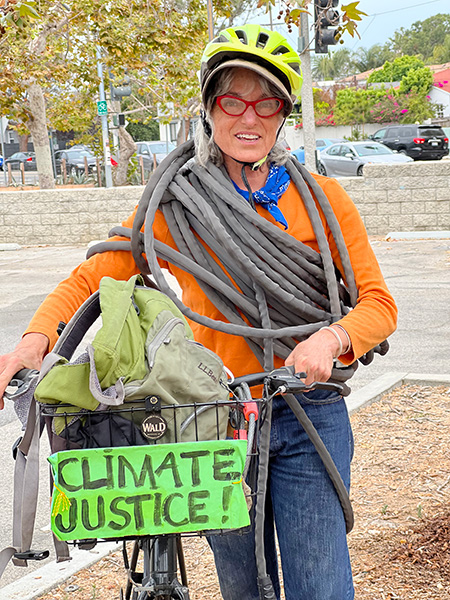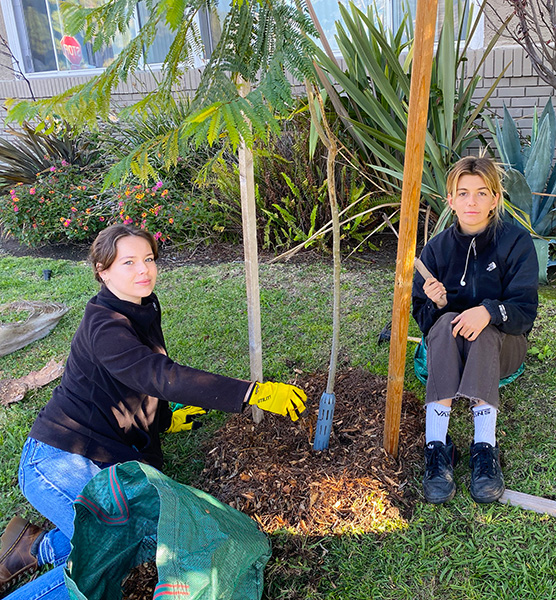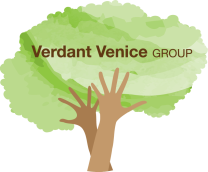


Verdant Venice Group brings the benefits of shade-providing trees to both neighbors and visitors alike.
If you think this is just hyperbole, think again. Despite all the noise from climate change deniers, leading climatologists worldwide agree that we’ve reached the point of do or die. Scientific research predicts that Los Angeles County residents can expect extreme heat days to quadruple in frequency by the year 2050 (Sun et al., 2015). According to a recent LA Times article, by the middle of this century, “temperatures in California are expected to rise by 4.4 to 5.8 degrees, and urban heat waves could cause two to three times more heat-related deaths” (Pineda, 2023). When faced with the distressing facts, it’s a challenge to maintain hope. Many Americans become paralyzed with fear, succumbing to a “what can I do about it?” attitude. The good news? There’s something all of us can do. Plant trees.
In a sunbaked metropolis like Los Angeles, shade is essential. Green space is woefully scarce in many parts of the city, and entire blocks are virtually treeless. This is particularly true in underserved communities, where the scorching summer sun mercilessly overheats sidewalks and residences. To experience this first-hand, just take a walk along the treeless streets of Los Angeles’ Boyle Heights neighborhood in late August, where the sun’s heat is relentless. Then head across town to the wealthy enclave of Los Feliz, where towering Cedars and Jacarandas shade the avenues. A 2016 study utilized spatial data to reveal that only 25% of Los Angeles is covered by tree canopy. 18% of that canopy is found in just a few areas including Pacific Palisades, Brentwood, Los Feliz and Shadow Hills – where a scant 1% of the city’s population lives (Seidman, 2024). To help address this inequity, the Metropolitan Water District of Southern California has announced a rebate program offering LA residents $100 per approved tree (up to $500) to help green their neighborhoods. Daniel Berger, the executive director of operations for the nonprofit TreePeople, comments that this tree incentive could enhance equity, insisting “The rebate program is particularly crucial for underserved communities, the least affluent communities that carry the heaviest environmental burden. It provides a means to make changes that might otherwise be unaffordable” (Seidman, 2024).
In urban areas lacking tree canopy, the heat island effect can be dramatic. The high concentration of structures like buildings and roadways with limited greenery creates “islands” of higher temperatures relative to outlying more rural areas (https://www.epa.gov/heatislands). According to the Dudek Report commissioned by the City of Los Angeles (2018, p.12), at peak heat of the day, unshaded surface temperatures can be 20 to 45 degrees higher than if shaded. Trees bring cooling relief.
Trees also help mitigate the toxic effect of greenhouse gases. One hundred mature trees can remove fifty-three tons of air pollutants including carbon dioxide annually. Trees store CO2 in their branches and within the surrounding soil, while releasing life-giving oxygen. They can also capture and store over 139,000 gallons of stormwater runoff each year. Studies show that by reducing airborne pollutants, tree cover can lower the rates of respiratory disease and decrease ozone levels (McPherson et al., 2011).
Greenhouse gases don’t just make our planet hotter and more polluted. The resulting climate change impacts tree species, pollinators and wildlife by threatening the survival of their natural habitat (https://www.arbordayfoundation.org). According to the U.S. Global Change Research Program & Climate Change Science Program (2024), “continued climate change threatens to reduce biodiversity in tree and plant communities, disrupt present ecosystems, and further the spread of invasive species.”
There are additional threats to biodiversity loss. The relentless onslaught of construction and rampant hardscaping add to the devastating loss of habitat. As a counteraction, when we add and replace trees, native shrubs and flowering plants lost to development, we provide critical support to wildlife. This aids in the battle against extinction. The understory also lends support to the trees overhead, where birds find sanctuary.
Planting trees is by no means the sole solution to climate change. Scientists across the globe agree that reducing carbon emissions from fossil fuels is crucial. The battle against climate disaster must be fought on this front as well. But while we remain dependent on corporations and legislation to fully accomplish fossil fuel reduction, planting native trees is something individuals have the power to do in their own neighborhoods.
Trees also bring additional rewards. They enhance our sense of well-being and quality of life by beautifying our neighborhoods. Recent studies remind us that when urban dwellers get closer to nature, their stress levels reduce (Gillerot et al., 2024; MaryCarol et al., 2019). This can be an antidote to feelings of climate change hopelessness, also known as eco-anxiety. In more than ten years of surveys, researchers at Yale and George Mason University have discovered that the number of those who admit to being “very worried” about global warming has sharply risen to describe at least 30% of Americans (Uppalapati et al., 2023). According to Therapist Karen Magruder, taking action can decrease fear. Planting trees is a great place to start. Magruder’s advice: “When you feel anxious, use that energy as fuel for the fight. Harnessing eco-anxiety in this way can reduce your sense of powerlessness.” (Magruder, 2023). And as we watch newly planted vegetation take root and grow, we are rewarded with the satisfaction of seeing change happen before our eyes.
Action and transformation can begin in our own back yards. Verdant Venice Group (VVG) is a grassroots not-for-profit community organization dedicated to increasing the native tree canopy and greening the understory throughout the Venice, California community. Since its founding in 2018, VVG has particularly focused on underserved and more treeless areas of Venice, including low-income housing complexes and community properties like the Venice Skills Center. As discussed, Los Angeles areas where residents have less disposable income typically have less green space, tree cover and overall landscape improvement. VVG seeks to right this inequity. In addition, the group focuses on well-traveled local thoroughfares and a variety of public spaces in need of landscape beautification. According to co-founder Isabelle Duvivier, VVG has planted and nurtured over 500 trees and 300-plus native shrubs and flowers that benefit local native wildlife.
VVG brings the benefits of shade-providing trees to both neighbors and visitors alike. Although Venice is a major Southern California tourist attraction, second only to Disneyland, city funding for improvement is scarce. During a 2023 in-person interview, Stephen DuPrey, City of Los Angeles Urban Forestry Supervisor, revealed that the City of Los Angeles only has budget to prune individual street trees every 17 years! In the Venice area, VVG is seeking to pick up this severe slack. The organization is committed to taking the charge in both planting and maintaining the local landscape. To that end, a multi-generational team of neighbors have rolled up their sleeves and swung into action. Coordinating with Recreation and Parks, LADOT and Bureau of Street Services to secure necessary permits, VVG members devote long hours of time and energy to realize the group’s mission. These dedicated volunteers – ranging in age from 8 to 83 – share a passion for gardening and a concern for the environment. Outreach and education are key. In partnership with local public schools, VVG introduces at-risk youth to the joys and benefits of gardening, with the aim of inspiring them to improve their own environment. The hope is that some of these young people will become climate warriors themselves, leading the future charge to combat impending disaster.
Grassroots efforts can go a long way toward solving the climate crisis. In 2024, a new VVG volunteer Lizzie had this to say: “Getting a live oak in the ground, staking, mulching, and watering it made me feel closer to the earth. Can’t wait to bike by over the years and watch my little oak grow tall!” We all have the power, just like Lizzie, to help save the planet. When we plant trees, we become hands-on in the restoration of the precious earth we share.
References
The Dudek Report https://www.cityplants.org/wp-content/uploads/2018/12/10939_LA-City-Plants_FirstStep_Report_FINAL_rev12-7-18.pdf
Using trees and vegetation to reduce heat islands. U.S. EPA
Loïc Gillerot, Dries Landuyt, Pieter De Frenne, Bart Muys, Kris Verheyen, Urban tree canopies drive human heat stress mitigation, Urban Forestry & Urban Greening, Volume 92, 2024, 128192, ISSN 1618-8667, https://doi.org/10.1016/j.ufug.2023.128192.
Magruder, K. (2023, Sept. 18) Keeping your cool in a warming world: 8 steps to help manage eco-anxiety. The Conversation.
MaryCarol, R. H., Brenda, W. G., & Sophie, Y.-P. C. (2019). Urban nature experiences reduce stress in the context of daily life based on salivary biomarkers. Frontiers in Psychology, 10. https://doi.org/10.3389/fpsyg.2019.00722
McNamara, K. A., Kostelny, M., Kim, G., Keating, D. M., Estiandan, J., & Armbruster, J. (2022). A novel resident outreach program improves street tree planting outcomes in los angeles. Environmental Challenges, 9. https://doi.org/10.1016/j.envc.2022.100596
McPherson, E. G., Simpson, J. R., Xiao, Q., & Wu, C. (2011). Million trees Los Angeles canopy cover and benefit assessment. Landscape and Urban Planning, 99(1), 40–50. https://doi.org/10.1016/j.landurbplan.2010.08.011
Pineda, D. (2023, August 24). California is working on solutions to worsening climate change: Will they be enough? The Los Angeles Times.
Seidman, L. (2024, March 6). Plant a tree, get $100 under new MWD program aimed at expanding SoCal’s tree canopy. The Los Angeles Times. Plant a tree, get $100 under new MWD program – Los Angeles Times
Sun, F., Walton, D. B., & Hall, A. (2015). A hybrid dynamical-statistical downscaling technique. part ii: end-of-century warming projections predict a new climate state in the los angeles region. Journal of Climate, 28(12), 4618–4636.
Uppalapati, S., Ballew, M., Campbell, E.’ Kotcher, J., Rosenthal, S., Leiserowitz, A., & Maibach, E. (2023). The prevalence of climate change psychological distress among American adults. Yale University and George Mason University. New Haven, CT: Yale Program on Climate Change Communication. https://climatecommunication.yale.edu/publications/climate-change-psychological-distress-prevalence/
